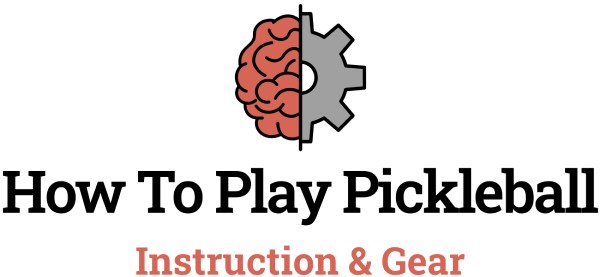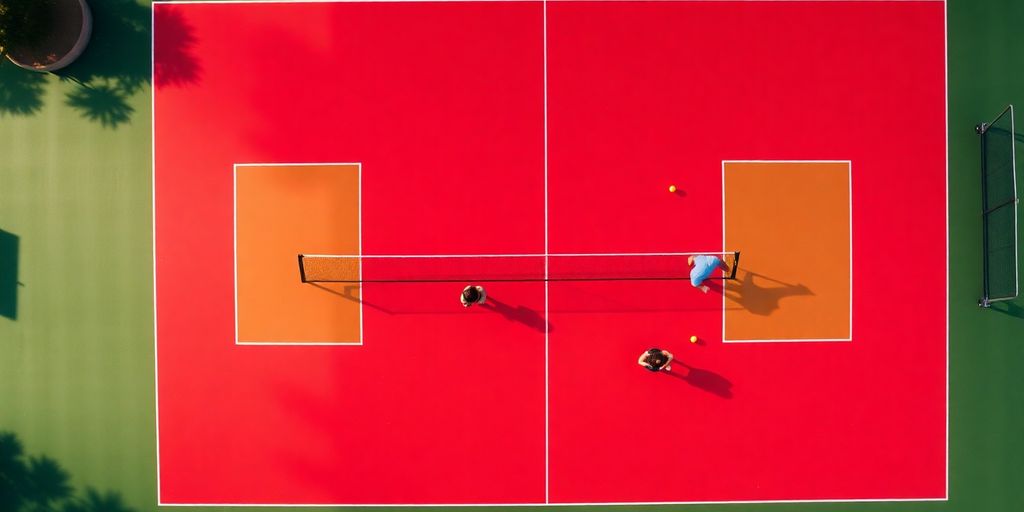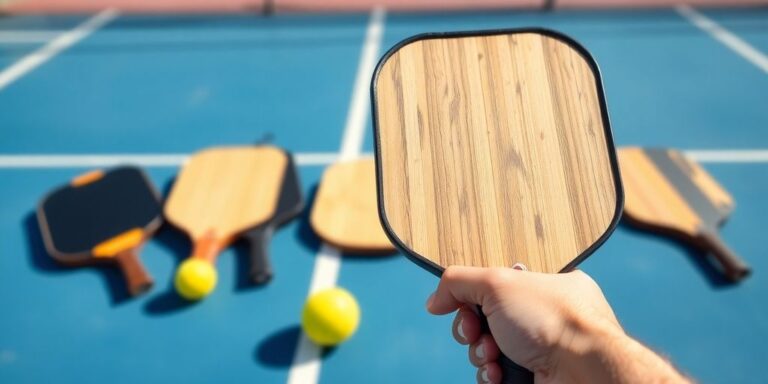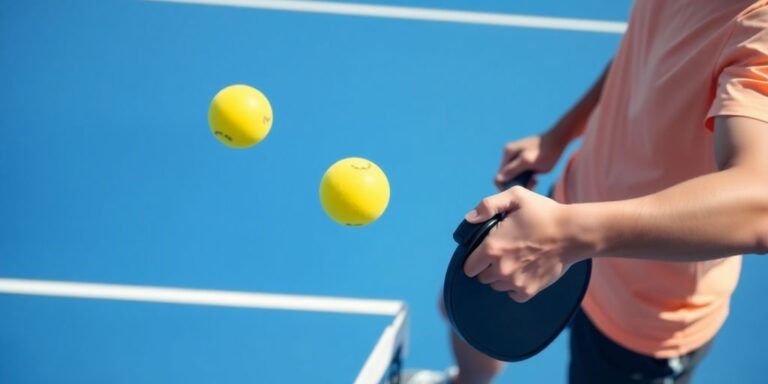Pickleball is getting super popular these days, and knowing the court measurements is a big deal if you want to play it right. Whether you’re setting up a court in your backyard or at a local gym, understanding the size and layout of a pickleball court is key. It affects everything from how you play to how fair the game is. This guide will break down all the details you need to know about pickleball court measurements. We’ll talk about the size, the lines, and even some tips on setting up your own court. So, if you’re into pickleball, stick around!
Key Takeaways
- Pickleball courts are 20 feet wide and 44 feet long, similar to a doubles badminton court.
- The non-volley zone, also known as the kitchen, is a 7-foot area near the net where you can’t volley.
- Court lines include sidelines, baselines, and centerlines that define the playing area.
- Indoor courts require attention to ceiling height, while outdoor courts need weather-resistant materials.
- Accurate court markings are crucial for fair play and enjoyable games.
The Importance of Understanding Pickleball Court Measurements
How Court Measurements Affect Gameplay
Pickleball is a game of precision, and understanding the court’s measurements can really change how you play. The court is a lot smaller than a tennis court, measuring 20 feet wide and 44 feet long. This smaller size means the game is fast-paced and demands quick reflexes. Knowing exactly where the lines are helps you make better decisions during a match, whether you’re deciding to let a ball go out or aiming for that perfect shot.
The Role of Measurements in Strategy Development
Every inch of the pickleball court can be used to your advantage if you know how to work it. For instance, the non-volley zone, often called the "kitchen," is a 7-foot area where volleys aren’t allowed. Mastering techniques like the dink shot within this space can give you an edge over your opponents. Understanding these zones helps you plan your next move and anticipate your opponent’s actions.
Why Accurate Measurements Ensure Fair Play
Fair play in pickleball starts with accurate court measurements. If the court is too big or too small, it can throw off the entire game. Playing on a court that’s set up correctly ensures everyone has the same chance to win. This uniformity is vital, especially in competitive settings, where even the smallest discrepancy can impact the outcome. So, whether you’re setting up a court at home or in a community center, sticking to the standard dimensions keeps the game fair and fun for everyone.
Knowing the exact dimensions of a pickleball court isn’t just about following the rules—it’s about enhancing the game itself. From strategy to fair play, these measurements are the foundation of every match.
Standard Measurements of a Pickleball Court
When you’re setting up for a game of pickleball, the first thing you need to know is the standard size of the court. A regulation pickleball court measures 20 feet wide and 44 feet long, which is the same for both singles and doubles play. This makes it about one-fourth the size of a tennis court, perfect for quick-paced games that don’t require a massive area. The court is divided into two equal halves by a net that stands 36 inches high on the sides and dips to 34 inches in the center.
Here’s a quick breakdown of the court’s measurements:
| Measurement | Feet | Meters |
|---|---|---|
| Court Width | 20 ft | 6.10 m |
| Court Length | 44 ft | 13.41 m |
| Non-Volley Zone | 7 ft | 2.13 m |
| Net Height (sides) | 36 in | 0.91 m |
| Net Height (center) | 34 in | 0.86 m |
The non-volley zone, also known as the "kitchen," is a crucial part of the court. It’s a 7-foot area on either side of the net where volleys are prohibited, adding a strategic element to the game.
Pickleball courts are often compared to tennis and badminton courts, but they are notably smaller. A tennis court is about 78 feet long and 36 feet wide for doubles, while a badminton court for doubles is 44 feet long and 20 feet wide—similar in length but not in width to pickleball. This compact size makes it easier to fit pickleball courts into smaller venues, like community centers or gyms.
The size of the pickleball court significantly influences how the game is played. A smaller court means that players need to be quick on their feet and have excellent reflexes. The shorter distance across the net allows for faster rallies and requires players to think strategically about their positioning. The limited space also encourages more interaction and communication between doubles partners, making teamwork essential.
Understanding the dimensions of a pickleball court can drastically change how you approach the game. It’s not just about hitting the ball over the net; it’s about knowing where to stand and when to move, making every match a test of strategy as well as skill.
Whether you’re setting up a court in your backyard or looking to improve your game, knowing these measurements can give you a real edge. And if you’re planning to watch a live match, having this knowledge enhances the experience, letting you appreciate the skill and strategy involved even more.
Breaking Down the Sections of a Pickleball Court
Understanding the Service Zones
Service zones in pickleball are where the game begins, and mastering them can set the tone for the entire match. These zones are 10 feet deep, extending from the net to the baseline. Getting your serve to land accurately within these boundaries is key to starting a rally effectively.
- Service Zone Dimensions: 10 feet deep
- Key Role: Initiates the rally
- Impact on Gameplay: Influences serve angle and speed
The Non-Volley Zone: Rules and Strategies
Known affectionately as the "kitchen," the non-volley zone is a 7-foot area on either side of the net. Here, players can’t hit the ball in mid-air, which adds a strategic layer to the game. Mastery of this zone can lead to skillful dink shots and control over the pace of the game.
- Non-Volley Zone Dimensions: 7 feet from the net
- Primary Rule: No volleys allowed
- Strategic Importance: Encourages precise movements and tactical play
The Significance of Baselines and Sidelines
Baselines and sidelines define the boundaries of the court. Shots landing outside these lines are out of play, making precision crucial. Understanding these boundaries helps players decide whether to swing for a shot or let the ball go.
- Baselines and Sidelines Dimensions: Court measures 20 feet wide and 44 feet long
- Role in Gameplay: Defines in-bounds and out-of-bounds
- Player Strategy: Aids in positioning and shot selection
Knowing the layout of a pickleball court isn’t just about following rules—it’s about using every inch of the court to your advantage. Whether it’s nailing that perfect serve in the service zone or mastering the art of dinking in the kitchen, understanding each section can elevate your game.
The Role of Court Markings in Pickleball

Decoding the Court Markings
Court markings in pickleball are like a map guiding players through the game. Each line and color serves a purpose, helping players understand their position and the boundaries of play. These markings are not just decorative; they are essential for navigating the court effectively.
How Markings Influence Player Movement
Court lines dictate where players can stand and move, especially during serves and volleys. Proper understanding of these markings can provide a strategic edge, allowing players to control the game better. For instance, staying just behind the non-volley zone, also known as "the kitchen," can help players make more effective shots without breaking the rules.
Maintaining Clear and Accurate Markings
Keeping court markings clear is crucial for fair play. Over time, lines can fade or become distorted, leading to confusion and disputes. Regular maintenance, like repainting lines and checking for wear, ensures that the game remains fair and enjoyable for everyone involved.
The precision of court markings can make or break a game. Just like in any sport, clarity and accuracy in pickleball lines are vital for maintaining the integrity of the game.
Key Points to Remember:
- Court lines are essential for understanding game rules and boundaries.
- Regular maintenance of markings helps in preventing gameplay issues.
- Strategic positioning based on markings can enhance your play.
Building and Maintaining a Pickleball Court
Essential Steps for Court Construction
Building a pickleball court is more than just laying down lines and setting up a net. It’s about creating a space where the game can be enjoyed to its fullest. Here’s a quick rundown of the steps involved:
- Select the Location: Choose a flat, level area with good drainage. Avoid spots that tend to collect water.
- Measure the Court: A standard court is 20 x 44 feet, but the playing area should be 34 x 64 feet to allow room for players to move around.
- Surface Selection: Opt for a durable material like asphalt or concrete for outdoor courts. For indoor courts, consider polyurethane surfaces for their cushioning properties.
- Court Marking: Use high-quality paint or tape for marking the lines. Ensure they are clear and accurate.
- Net Installation: Set up the net at 36 inches high on the sides and 34 inches at the center.
- Consider Fencing: If possible, install fencing to keep the ball contained within the court.
Common Mistakes to Avoid When Building
Building a court can be tricky, and there are some common pitfalls to watch out for:
- Ignoring Orientation: Position the court north to south to minimize sun interference during play.
- Overlooking Noise Concerns: Check local regulations regarding noise, especially if the court is in a residential area.
- Crowding the Space: Ensure there is ample space between courts if you’re building more than one.
Tips for Maintaining Court Quality
Keeping your court in top shape is crucial for safe and enjoyable play. Here are some maintenance tips:
- Regular Cleaning: Sweep the court to remove debris and prevent damage. A clean court reduces the risk of slips and falls.
- Inspect for Damage: Check for cracks or uneven surfaces regularly and repair them promptly.
- Repaint Lines: Keep the court lines visible and accurate by repainting them as needed.
Regular maintenance not only extends the life of your pickleball court but also enhances the playing experience for everyone. By staying on top of repairs and cleanliness, you’ll ensure that your court remains a welcoming place for players of all skill levels.
By understanding these key aspects of pickleball court installation and maintenance, you’ll create a high-quality playing environment that stands the test of time. Whether you’re a DIY enthusiast or considering professional help, these steps will guide you in the right direction.
Adapting Pickleball Court Measurements for Different Settings
Indoor vs Outdoor Court Considerations
When it comes to pickleball, the setting can really change how the game is played. Indoor courts often use hardwood or synthetic surfaces, which can be slick, especially if not well-maintained. On the other hand, outdoor courts usually have concrete or asphalt surfaces with an acrylic coating, providing better traction but subject to weather conditions. Lighting is another factor; indoor courts need good artificial lighting, while outdoor courts rely on natural light, which can vary. These differences can affect everything from ball bounce to player movement.
Adjusting Court Size for Limited Spaces
Not everyone has access to a full-sized pickleball court, but that doesn’t mean you can’t play. For smaller spaces, consider reducing the court size while maintaining the essential elements. A typical pickleball court is 20 feet by 44 feet, but you can adjust the dimensions to fit your space. Just ensure that the court remains proportionate, keeping the net height and the non-volley zone consistent. This way, you can still enjoy the game even if your space is limited.
Temporary vs Permanent Court Setups
Temporary setups are a great option if you’re working with a multi-use space. You can use tape for lines and portable nets, which are easy to set up and take down. This flexibility is perfect for community centers or gyms that host various activities. Meanwhile, permanent courts offer durability and a more professional feel, with painted lines and fixed net posts. However, they require a dedicated space and are more costly to install. Whether temporary or permanent, each setup has its own benefits depending on your needs.
Enhancing Your Game Through Court Measurements

Using Measurements to Improve Skills
Understanding the dimensions of a pickleball court isn’t just about knowing where to stand; it’s about leveraging that knowledge to boost your skills. When you know the exact size of the service zones, you can practice serves that land precisely where they should. This precision can set the tone for a rally, putting your opponent on the defensive from the get-go. Additionally, mastering the non-volley zone, or "kitchen," is crucial. This 7-foot area near the net is where many games are won or lost. By practicing your movements and shots here, you can improve your control and finesse, leading to more successful volleys and dinks.
Practice Drills Focused on Court Dimensions
To make the most of the court’s dimensions, try incorporating specific drills into your practice routine:
- Serve Placement Challenge: Aim to serve within different sections of the service zone to increase accuracy and control.
- Non-Volley Zone Practice: Focus on dinking and volleys within the kitchen to improve your net game.
- Sideline Accuracy Exercise: Work on hitting shots close to the sidelines to keep your opponent guessing.
These drills not only hone your skills but also help you understand how to use the court’s layout to your advantage.
Strategic Positioning Based on Court Layout
Positioning is key in pickleball, and understanding the court’s layout can give you a tactical edge. By knowing the exact measurements, you can position yourself better during serves and rallies, making it easier to control the flow of the game. For instance, standing just behind the baseline during a serve can give you a better angle for your return. Similarly, being aware of the kitchen’s boundaries helps you avoid faults while setting up strategic plays.
Boldly embracing the court’s dimensions can transform your game, turning the court from a simple playing field into a strategic tool.
Incorporating these elements into your practice can significantly enhance your gameplay, making you a more formidable opponent on the court.
Understanding court measurements can significantly improve your pickleball skills. By knowing the dimensions and layout of the court, you can strategize better and enhance your gameplay. Don’t miss out on valuable insights and tips! Visit our website to learn more and take your game to the next level!
Wrapping It Up
So, there you have it! Getting the hang of pickleball court measurements isn’t just for the pros. Whether you’re setting up in your backyard or at a local park, knowing the right dimensions can make all the difference. It’s not just about the numbers; it’s about making sure the game is fair and fun for everyone. From the net height to the kitchen line, each part of the court has its own role in the game. So next time you pick up that paddle, you’ll know exactly where to stand and how to play your best game. Happy playing!
Frequently Asked Questions
What are the official dimensions of a pickleball court?
A standard pickleball court is 20 feet wide and 44 feet long. These measurements are the same for both indoor and outdoor courts.
Can I build a smaller pickleball court in my backyard?
Yes, you can make a smaller court to fit your backyard, but you should adjust the layout to keep the game fun and fair.
How do I mark the lines on a pickleball court?
To mark the lines, measure carefully and use paint or tape made for sports courts. This helps players see where the lines are during the game.
What should I think about when designing my own pickleball court?
Consider if the court will be permanent or temporary, the type of surface, net height, and making sure the markings are clear for proper play.
Is there an easy way to set up temporary pickleball courts?
Yes, you can use cones, rulers, and chalk to quickly set up a temporary court. This way, you can see the boundaries without making permanent changes.
Why is it important to know pickleball court dimensions?
Knowing the court dimensions helps you play better and ensures fair play. It also helps you set up the court correctly, whether it’s for casual or competitive play.




